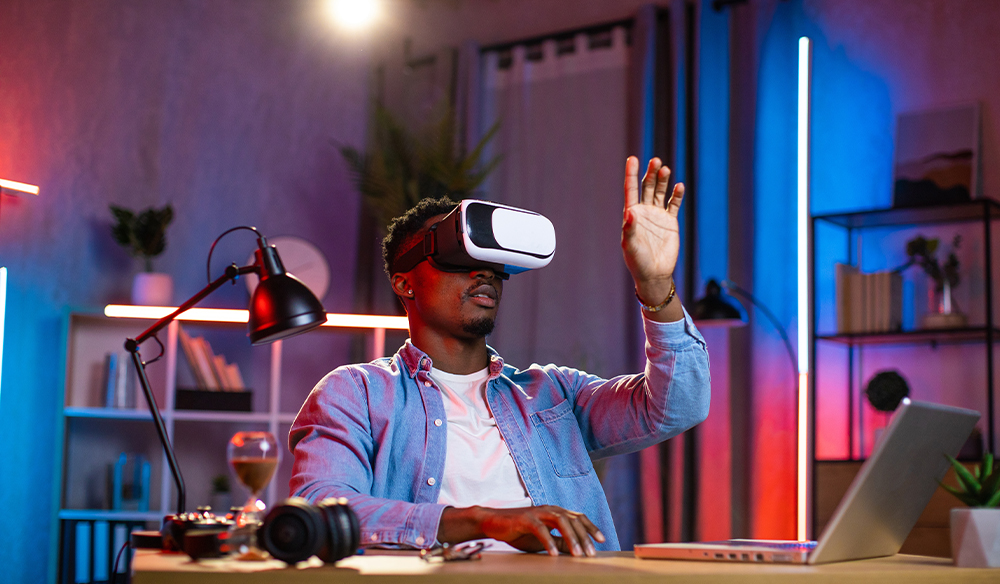
Virtual Reality: The Promising Future of Immersive Technology
What is virtual reality?
Virtual reality is an end-to-end digital mechanism that mimics our natural surroundings through computer programming. In virtual reality, lifelike representations of humans react with virtual objects via mobiles or VR headsets to perform everyday tasks. These interactions are supplemented with cloud computing, AI, and multisensory human stimuli.
Also known as the technology behind the “metaverse,” virtual reality combines multiple virtual spaces focused on building social connections. One day spent in virtual reality space is equal to thirty minutes of time spent in real life.
Unlike augmented reality, where you can overlay digital objects in your space and interact with them, virtual reality places a user in a virtual dimension through computer graphics, AI sensors, head, and body trackers. Combining VR hardware and software components creates an immersive experience for the end user. Objects like walls, tables, or sofas, act as a demarcation in the virtual world to prevent bumping into any obstacle.
Importance of virtual reality
Everything that makes up our perception of reality is due to our senses. So, in theory, everyone’s truth is unique to them. If you provide your senses with simulated or artificial information, your perception of reality changes – creating a new, virtual one.
As market trends continue to evolve, virtual reality gives scope for a generous profit leap for diverse businesses. Many have already started investing in VR to create virtual demos of products and empower their workforce.
Modern-age gamers stream their content via VR projection from different geographical locations to expand their reach. However, the other industries are not far behind. Real estate, retail, supply chain, and logistics sectors are also eyeing VR for themselves.
Let’s figure out why:
- Customer-driven: Virtual reality crafts personalized virtual experiences as opposed to traditional modes of media, below-the-line marketing, newspaper, and press releases.
- 3D Product visualization: Virtual demos showcase every minute detail in an extensive 3D environment.
- Artistic inclinations: VR experiences are art-influenced and create a dominating stride for consumers.
- Virtualized meetings: Meetings, training sessions, conferences, concerts, and other cross-team interactions can be held in a commonplace via VR.
- Unpleasant confrontations: Hesitant interactions with peers and superiors can be significantly decreased in a virtual space.
- Built-in haptic and audio sensors: A full VR experience constitutes haptic (touch) and audio stimuli to immerse a user completely till they lose touch with reality.
- Excellent branding: Companies can provide 3D feedback access to consumers to establish a brand reputation.
- Undisrupted training: VR creates an undisturbed learning flow for employees and trains them on soft skills with ease.
When humans identify objects, we use their size relative to each other to judge distance and purpose. In the same way, VR mimics the natural brain actions and body movements to evoke a sense of realism for the user.
Here’s how humankind set foot on the virtual reality journey.
History of virtual reality
Virtual reality has come a long way in the last 50 years but is still considered an emerging tech. Funny how that works.
The first VR flight simulator was designed in 1929 and was known as a Link Trainer. Edwin A. Link, the inventor, used it to train pilots under dangerous flying conditions. This simulator emulated real flight windshields for them to practice flying an aircraft.
Some decades later, in 1961, Thomas Furness, a military engineer, developed the first flight simulator for the US Air Force. It sparked a lot of interest in VR technology and how it could be used for training purposes.
The actual term “virtual reality” was coined much later in 1987 by researcher Jaron Lanier.
Let’s learn about how virtual reality technology traversed from the olden days to its golden days.

Leave a Reply